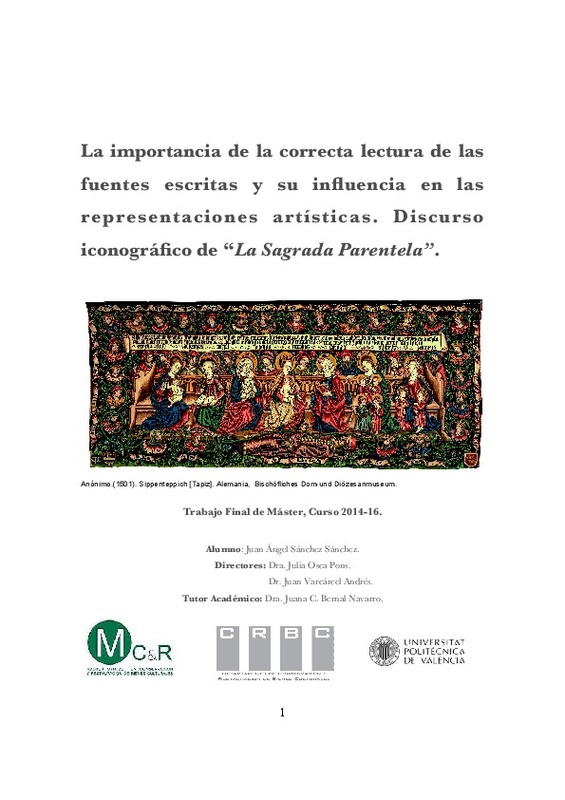JavaScript is disabled for your browser. Some features of this site may not work without it.
Buscar en RiuNet
Listar
Mi cuenta
Estadísticas
Ayuda RiuNet
Admin. UPV
Importancia de la correcta lectura de las fuentes escritas y su influencia en las representaciones artísticas. Discurso iconográfico de La Sagrada Parentela
Mostrar el registro sencillo del ítem
Ficheros en el ítem
| dc.contributor.advisor | Valcárcel Andrés, Juan Cayetano
|
es_ES |
| dc.contributor.advisor | Osca Pons, Mª Julia
|
es_ES |
| dc.contributor.advisor | Bernal Navarro, Juana Cristina
|
es_ES |
| dc.contributor.author | Sánchez Sánchez, Juan Ángel
|
es_ES |
| dc.date.accessioned | 2016-11-04T13:11:07Z | |
| dc.date.available | 2016-11-04T13:11:07Z | |
| dc.date.created | 2016-07-12 | |
| dc.date.issued | 2016-11-04 | es_ES |
| dc.identifier.uri | http://hdl.handle.net/10251/73305 | |
| dc.description.abstract | [EN] This research arises from the need to give explanation of some female characters that appear or disappear to particular iconographic models, depicting the story of Jesus even created on purpose as "The Holy Kinship", for theological issues, trends or popular beliefs. These variations in representations lead to the questioning of the reasons that lead the artist to omit or to observe the different female characters, from compositional reasons, possible extras, issues of patronage or simple mourners, to filial relations with the Virgin Mary. This requires both a new vision and reading the roles have been taking some characters throughout history understanding the sources written with rigor and consistency in themselves, as well as monitoring of works of art that help us to unravel the kinship with which they have represented awareness for devotional exercise. To do this we must study the different variables that present relationship and understand the reasons why these considerations do not reach our present within the Christian tradition. Our intention is to understand and argue in what time and in what specific works could be talking about it to assess the correctness of the criteria that have been used so far since the iconography. Finally it exemplified by the iconographic analysis the different types of possible works based on our research, in order to demonstrate that ignorance or censorship with which works of art are analyzed, offers partial information of artistic reality. It could being able to offer new information about the intentions, beliefs or monitoring of the iconographic guidelines set by orthodoxy, thus generating a new vision of both the work and the artis | es_ES |
| dc.description.abstract | [ES] El presente proyecto de investigación tiene como objeto el estudio iconográfico de la representación sacra La Sagrada Parentela , centrando el trabajo en un exhaustivo análisis de las fuentes escritas hagiográficas, neotestamentarias, apócrifas, y textos visionarios. Incidiendo en la influencia de los textos en las imágenes representadas. Este estudio pretende disgregar las variables iconográficas que se han desarrollado a lo largo de la historia del arte y argumentar, en la medida de lo posible, en calidad de qué parentesco están representados algunos de los personajes femeninos que aparecen en esta temática específica de carácter cristiano. | es_ES |
| dc.language | Español | es_ES |
| dc.publisher | Universitat Politècnica de València | es_ES |
| dc.rights | Reserva de todos los derechos | es_ES |
| dc.subject | Iconografía | es_ES |
| dc.subject | Fuentes escritas | es_ES |
| dc.subject | Sagrada Parentela | es_ES |
| dc.subject.classification | PINTURA | es_ES |
| dc.subject.other | Máster Universitario en Conservación y Restauración de Bienes Culturales-Màster Universitari en Conservació i Restauració de Béns Culturals | es_ES |
| dc.title | Importancia de la correcta lectura de las fuentes escritas y su influencia en las representaciones artísticas. Discurso iconográfico de La Sagrada Parentela | es_ES |
| dc.type | Tesis de máster | es_ES |
| dc.rights.accessRights | Abierto | es_ES |
| dc.contributor.affiliation | Universitat Politècnica de València. Departamento de Conservación y Restauración de Bienes Culturales - Departament de Conservació i Restauració de Béns Culturals | es_ES |
| dc.description.bibliographicCitation | Sánchez Sánchez, JÁ. (2016). Importancia de la correcta lectura de las fuentes escritas y su influencia en las representaciones artísticas. Discurso iconográfico de La Sagrada Parentela. http://hdl.handle.net/10251/73305 | es_ES |
| dc.description.accrualMethod | TFGM | es_ES |
| dc.relation.pasarela | TFGM\50000 | es_ES |






